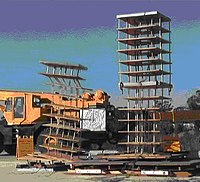
Photo from wikipedia
The seismic performance assessment of dry-joint masonry arches is challenging because of their unique structural characteristics. Widely used assessment methods developed for frame-type structures require the use of a material-dependent… Click to show full abstract
The seismic performance assessment of dry-joint masonry arches is challenging because of their unique structural characteristics. Widely used assessment methods developed for frame-type structures require the use of a material-dependent section response. In contrast, the response of a dry-joint arch is not dependent on the material capacity but characterized by the sustainment of stability, primarily depending on rigid body rotation or sliding motion at the interfaces between the adjacent voussoirs. A hybrid methodology, combining a simple finite element micro model with principles of limit analysis method, is proposed in this work for the seismic performance assessment of these structures. The nonlinearity is concentrated at interfaces of the model by means of shear and compression-only axial springs. Kinematic conditions yielding a possible collapse mechanism were traced at every step of the time history analysis by checking the failure of individual interfaces. The procedure is applied to an ancient dry-joint Roman arch bridge in close proximity to the North Anatolian fault subject to significant seismic risk. Along with the performance of the system in its current state, the effects of retrofitting measures were investigated in the scope of this study.
Journal Title: Buildings
Year Published: 2021
Link to full text (if available)
Share on Social Media: Sign Up to like & get
recommendations!